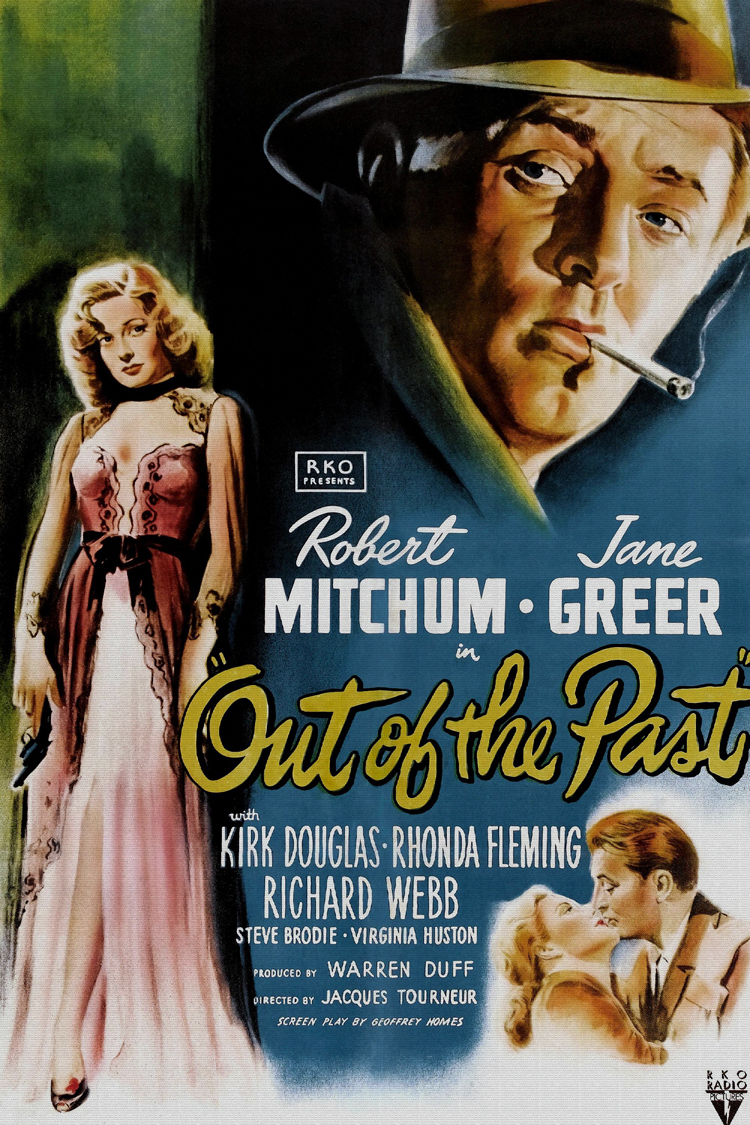
15 Feb Fashion in Classic Film Noir: Out of the Past (1947)
Before I drive right in, I’d like to begin with a short introduction: This is the first part in a series on fashion in classic film noir and the ways in which it contributes to the story in each case.
Old Hollywood film and its history is a great hobby of mine. I’ve watched every film that will be featured and everything I’m writing is based on my personal opinions as well as supporting facts from books and around the web, which, if applicable, will be posted at the bottom of each post.
The fashions in film noirs are some of my favourite costumes. There is something specific and special about them, from the seductive femme fatale gowns to the trench coats and felted fedora, that make them pure joy to watch. (Although, for today’s audiences much of the content seems cliché and over the top-it’s Hollywood, after all!)
Now, to begin the series, I want to start off with my favourite, Out of the Past (1947) starring Robert Mitchum and Jane Greer. If I had to choose one film that completely and effectively uses all aspects of the film noir, it would, without a doubt, be this one. These elements include flashbacks, a deadly but irresistible femme fatale, an investigator or detective, a dangerous villain, oppressive high contrast lighting, voiceover narration, and an excellent layering of themes like betrayal, corruption, and moral ambiguity. (If you’re interested in what all makes up perfect film noir, this infographic lays it out.)
Mitchum’s character is private detective Jeff Bailey (who’s name, we discover about 10 minutes in, isn’t Jeff Bailey—it’s Jeff Markham; he had to change his name to escape his past—but for consistency’s sake, we’ll call him Bailey). Although now living quietly as the owner of a gas station in a small town in California and dating resident good girl, Ann, he is soon found by a character from his past, Joe (Paul Valentine), who convinces him to see their “old friend” in Lake Tahoe. That same night, driving up to Tahoe, Bailey confesses his past to Ann: cue flashback.
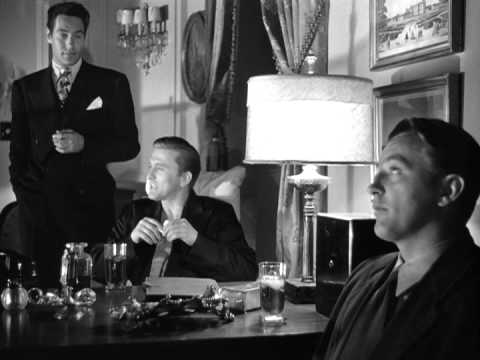
The flashback begins when Bailey is hired to track down Kathie (Greer) by her crooked gambler boyfriend, Whit Sterling (Douglas) after she stole $40k from him and “taken 4 shots at him with his own .38—made one of ’em good.” The scene above is at Whit’s mansion in Lake Tahoe. Notice Joe, Whit’s goon, dressed in a sleazy suit, and Whit himself in a casual smoking robe. Both costumes clearly define their roles without us even having to be explicitly told. Bailey and his partner, Jeff Fisher (Steve Brodie, not pictured), both wear heavy overcoats and fedoras typical of your average film noir detective.
Anyway, Whit doesn’t care about the money. He just wants Kathie back, telling Bailey, “When you see her, you’ll understand better.”
And, of course, he does.
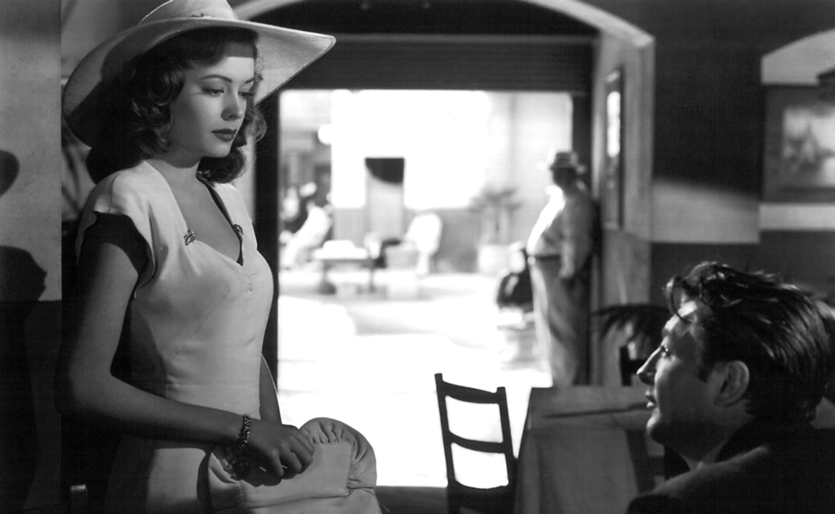
We meet Kathie dressed in white. As this scene is included in his running flashback, this is Bailey’s memory of her, and in his memory she’s an innocent, something out of a dream.
Bailey has tracked her down to a Mexican cantina where she is obviously suspicious of him from the get-go, treating him coldly, but Bailey, immediately deterred from his mission, has naively already begun falling for her. You can hardly blame him, I mean look at the still below; the lighting makes her look simply angelic.
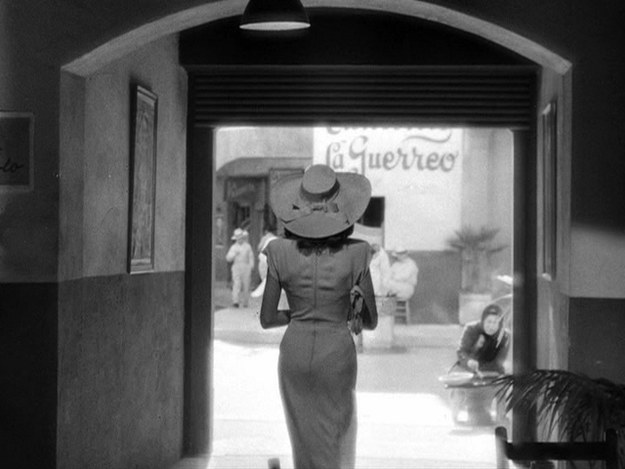
The outfit below from their second meeting is similar in illustrating Bailey’s disillusionment with Kathie as a harmless victim. I had to include it because I love her holding the cigarette with her gloved hand—so glamorous.
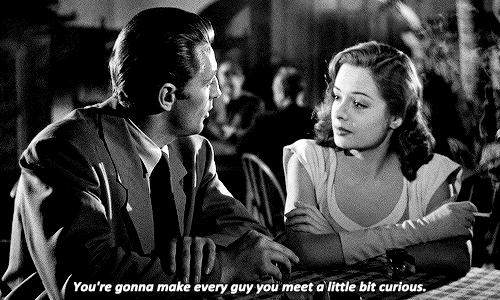
Moving on, they have a romance in Mexico and then decide to run away to San Francisco and start new life together…
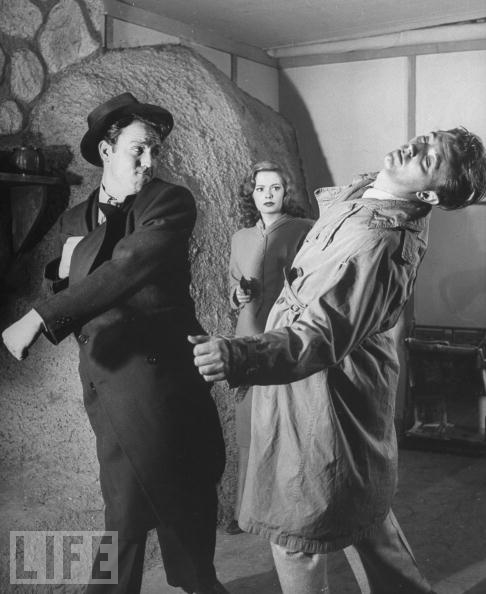
That doesn’t last long.
Fisher (now hired by Whit to track down Bailey) finds them, so the couple have to split up for a short time. When they think it’s safe enough, they meet at a secluded cabin in the woods, but Fisher crashes the party and begins a fight with Bailey over the money they were supposed to split for finding Kathie. Now, he wants the $40,000—which Bailey is still in denial Kathie stole. Kathie watches on as the fight gets physical, her face twisting cruelly into a smile as she pushes herself back against the wall.
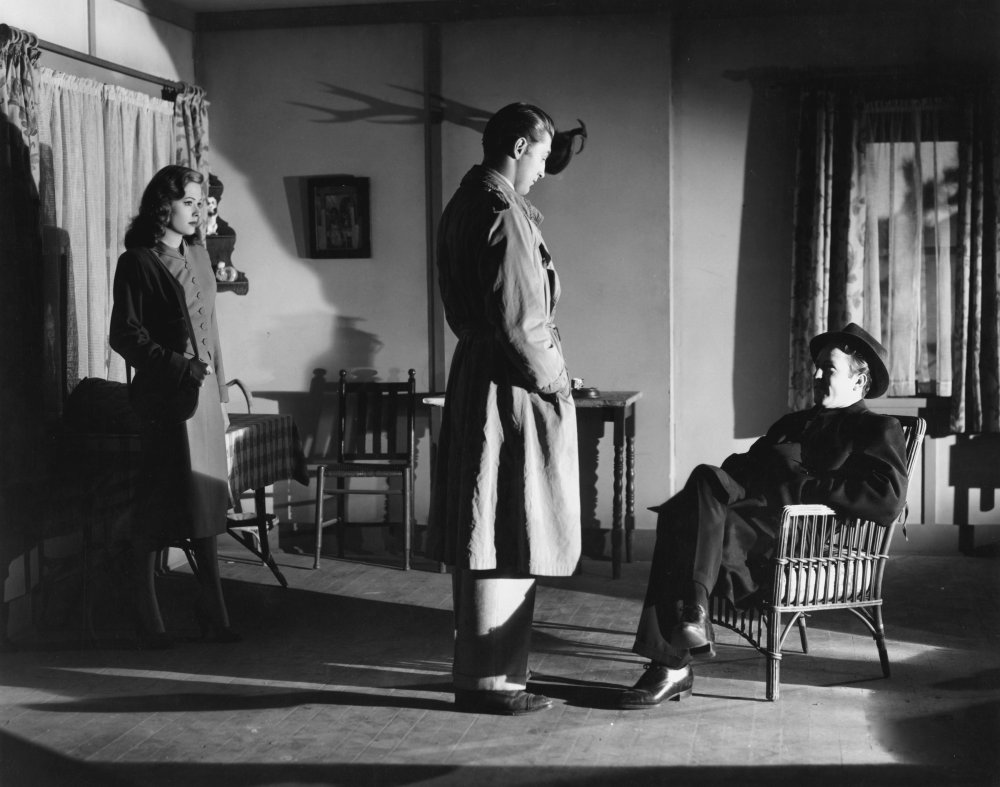
The ambiguity of her costume reflects the moral ambiguity of her character—its grey colour palette, too, is ambiguous. Note the harsher light in the still above (in comparison to the ones in Mexico), the way she’s obscured by the shadows.
Yet Bailey is still unable to believe her guilt or her capability for ruthlessness even as she shoots his ex-partner right in front of him. He tells her she “didn’t have to kill him.” She insists she had to do it, then runs out of the cabin and drives away; he lights a cigarette and buries Fisher, covering up the murder.
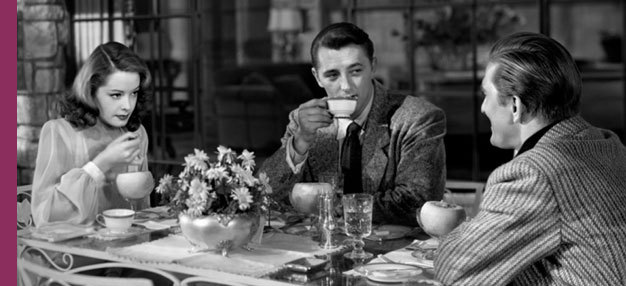
After this scene, we return to the present, where Bailey arrives at the Tahoe mansion and Ann drives back home alone, promising to wait for him. Whit, (creepily) friendly as ever but certainly aware of something going on, assigns Bailey a new job over breakfast with Kathie, who has come back to Whit!
Awkward.
And she’s in white again—a brief return to her innocence (“Jeff, I had to come back. What else could I do?”).
He can’t seem to say “no” to the job, even though he feels betrayed by Kathie. He still somehow sees her as an innocent. Whit uses this to his advantage and as a plan to get revenge on Bailey. This will all end in the murder of Whit’s tax attorney (who is threatening to expose him for the con he is), for which Bailey will be framed.
In the final stage of the film, Bailey finds the tax attorney murdered, as he had suspected would happen, and hides the body in the closet. His fingerprints are, of course, all over the crime scene, but never mind that.
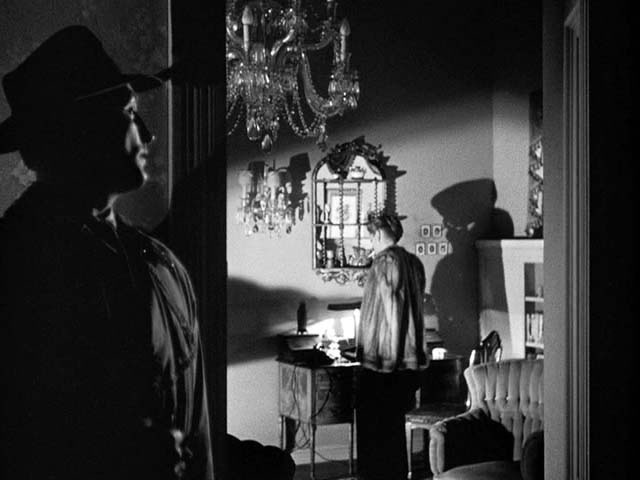
Sneaking back into the mansion, he then listens in on Kathie’s phone calls (above) and discovers that she is an integral player in his being framed for the murder. She has, in fact, been deceiving him all along, but he was so deluded by his perceptions of her that he was unable to see it until the end.
From here, there’s many twists and turns and a laughably broad-shouldered fur coat (phone call scene, above), but I’m going to skip over all that to get to the last major costume in Kathie’s transformation.
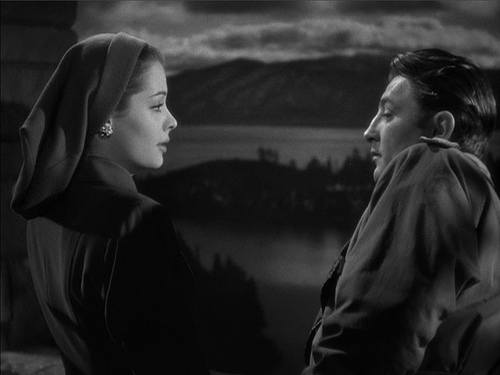
Here she is in her final stage. It’s an unusual outfit—one might describe it as saintly, reminiscent of a religious habit. It’s so modest it’s unbecoming to her because by now we know what she’s done. (Obviously the costume designer was cleverly showing us contrast!)
In the scene below, Bailey has just found Whit’s dead body on the floor of the mansion. Kathie tries to convince Bailey they can start all over again now that she killed Whit for them (actually, her tail was on the line for messing up Whit’s plan for Jeff—this part is way too confusing, you have to watch it to understand).
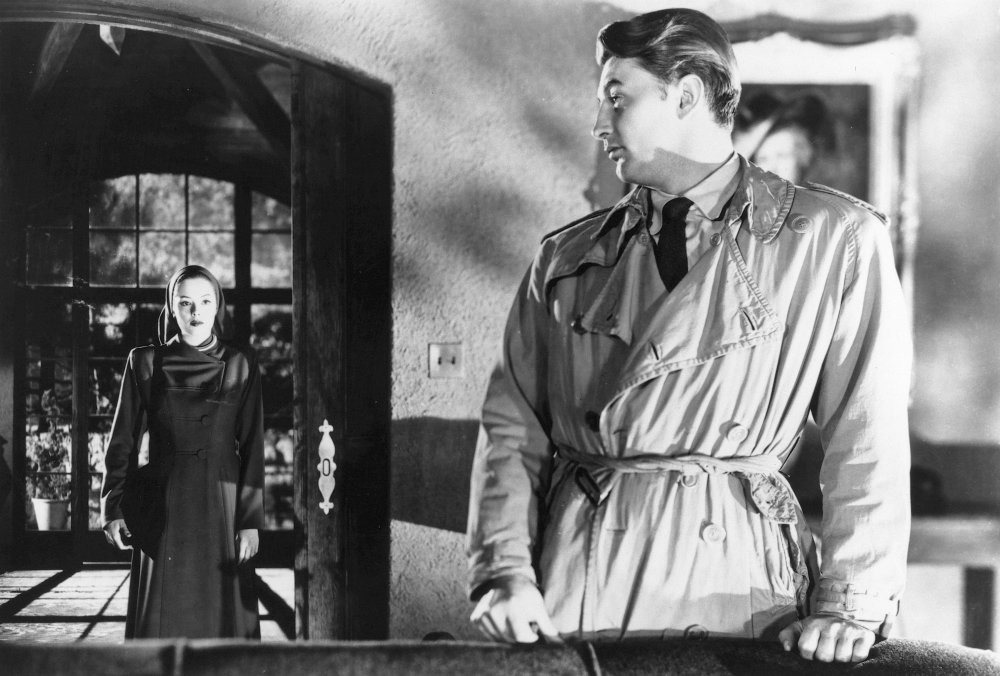
No matter how she tries to dress it up, it’s still murder. Unlike before, all the stories she makes up proclaiming her innocence sound ridiculous to Bailey now that he’s “stepped into the light,” and her power over him is gone. However, he allows her to believe she still has the upper hand: he phones the police while she packs her things, and on their drive out of town, they encounter a police road block where Kathie puts two and two together (below).
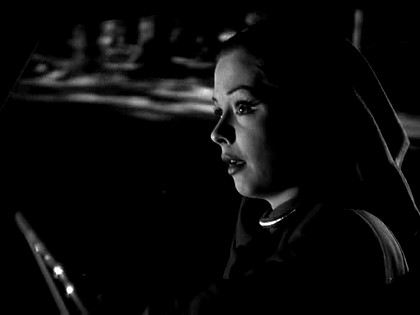
The ending is a brutal mix of gunshots and a car crash that ends with “morally necessary” justice delivered in the form of both of their deaths—because, according to the Hollywood Production Code in effect at the time, crime can never pay, and bad guys can never win.


